

Historiography. Historiography refers to both the study of the methodology of historians and the development of "history" as a discipline, and also to a body of historical work on a particular subject.

List of pre-modern great powers. The historical term "Great Nation",[3][4][5] distinguished aggregate of people inhabiting a particular country or territory, and "Great Empire",[6] considerable group of states or countries under a single supreme authority, are colloquial; use is seen in ordinary historical conversations (historical jargon).

History[edit] Ancient powers[edit] Ancient Near East[edit] The term ancient Near East encompasses the early civilizations during the time roughly spanning the Bronze Age from the rise of Sumer and Gerzeh in the 4th millennium BCE to the expansion of the Persian Empire in the 6th century BCE. The ancient Near East is generally understood as encompassing Mesopotamia (modern Iraq and Syria), Persia (modern Iran), Armenia, the Levant (modern Israel, Jordan, Lebanon, Syria, Palestinian Authority), and at times Anatolia (modern Turkey) and Ancient Egypt. Sumer and Akkad[edit] Ancient Babylon was officially conquered by the Achemidian Persian Empire in the late 6th century BCE. Elam[edit]
History of science. "New science" redirects here.
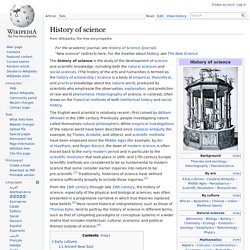
For the treatise about history, see The New Science. Development criticism. Economic history of the world. Timeline of World Economy For the history of money see History of Money.
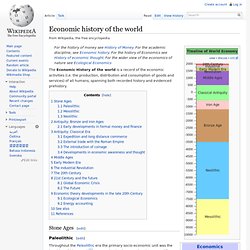
For the academic discipline, see Economic history. For the history of Economics see History of economic thought. For the wider view of the economics of nature see Ecological Economics The Economic History of the world is a record of the economic activities (i.e. the production, distribution and consumption of goods and services) of all humans, spanning both recorded history and evidenced prehistory. Stone Ages[edit] Paleolithic[edit] Cantino planisphere. History[edit] West and the recently reached Americas, Tordesillas line depicted - Cantino planisphere detail.
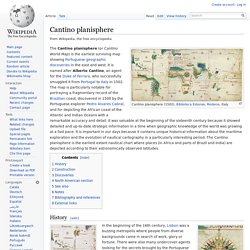
Age of Discovery. The Age of Discovery is a period of European global exploration that started in the early 15th century with the first Portuguese discoveries in the Atlantic archipelagos and Africa, as well as the discovery of the Americas by Spain in 1492, and the Portuguese discovery of the ocean route to the East in 1498, and by a series of European naval expeditions across the Atlantic and later the Pacific, which continued until the 18th century.
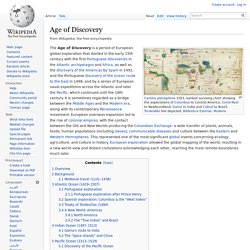
It is sometimes regarded as a bridge between the Middle Ages and the Modern era, along with its contemporary Renaissance movement. Renaissance. The Renaissance (UK /rɨˈneɪsəns/, US /ˈrɛnɨsɑːns/, French pronunciation: [ʁənɛsɑ̃s], from French: Renaissance "re-birth", Italian: Rinascimento, from rinascere "to be reborn")[1] was a cultural movement that spanned the period roughly from the 14th to the 17th century, beginning in Italy in the Late Middle Ages and later spreading to the rest of Europe.

Though availability of paper and the invention of metal movable type sped the dissemination of ideas from the later 15th century, the changes of the Renaissance were not uniformly experienced across Europe. In politics, the Renaissance contributed the development of the conventions of diplomacy, and in science an increased reliance on observation. Historians often argue this intellectual transformation was a bridge between the Middle Ages and Modern history. Overview[edit] The Renaissance was a cultural movement that profoundly affected European intellectual life in the early modern period. Modern history. Modern history, also referred to as the modern period or the modern era, is the historiographical approach to the timeframe after the post-classical era (known as the Middle Ages).[1][2] Modern history can be further broken down into the early modern period and the late modern period after the French Revolution and the Industrial Revolution.

Contemporary history is the span of historic events that are immediately relevant to the present time. The modern era began approximately in the 16th century.[3][4] The study of modern history[edit] Some events, while not without precedent, show a new way of perceiving the world. Early modern period. In history, the early modern period of modern history follows the late Middle Ages of the post-classical era.
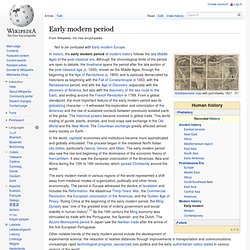
Although the chronological limits of the period are open to debate, the timeframe spans the period after the late portion of the post-classical age (c. 1500), known as the Middle Ages, through the beginning of the Age of Revolutions (c. 1800) and is variously demarcated by historians as beginning with the Fall of Constantinople in 1453, with the Renaissance period, and with the Age of Discovery (especially with the discovery of America, but also with the discovery of the sea route to the East), and ending around the French Revolution in 1789. From a global standpoint, the most important feature of the early modern period was its globalizing character — it witnessed the exploration and colonization of the Americas and the rise of sustained contacts between previously isolated parts of the globe.
The historical powers became involved in global trade. Early modern timeline[edit] History of Africa. African States between 500 BCE and 1500 CE The history of Africa begins with the prehistory of Africa and the emergence of Homo sapiens in East Africa, continuing into the present as a patchwork of diverse and politically developing nation states.

Some early evidence of agriculture in Africa dates from 16,000 BCE,[1] and metallurgy from about 4000 BCE. Middle Ages. In European history, the Middle Ages, or Medieval period, lasted from the 5th to the 15th century. It began with the collapse of the Western Roman Empire and merged into the Renaissance and the Age of Discovery. The Middle Ages is the middle period of the three traditional divisions of Western history: Antiquity, Medieval period, and Modern period. The Medieval period is itself subdivided into the Early, the High, and the Late Middle Ages. Depopulation, deurbanisation, invasion, and movement of peoples, which had begun in Late Antiquity, continued in the Early Middle Ages.
The barbarian invaders, including various Germanic peoples, formed new kingdoms in what remained of the Western Roman Empire. During the High Middle Ages, which began after AD 1000, the population of Europe increased greatly as technological and agricultural innovations allowed trade to flourish and the Medieval Warm Period climate change allowed crop yields to increase. Etymology and periodisation[edit] Postclassical Era. Empire. Imperialism and colonization in 1900 The term empire derives from the Latin imperium (power, authority). Politically, an empire is a geographically extensive group of states and peoples (ethnic groups) united and ruled either by a monarch (emperor, empress) or an oligarchy. Aside from the traditional usage, the term empire can be used in an extended sense to denote a large-scale business enterprise (e.g., a transnational corporation), or a political organisation of either national-, regional- or city scale, controlled either by a person (a political boss) or a group authority (political bosses).[1] An imperial political structure is established and maintained in two ways: (i) as a territorial empire of direct conquest and control with force (direct, physical action to compel the emperor's goals) or (ii) as a coercive, hegemonic empire of indirect conquest and control with power (the perception that the emperor can physically enforce his desired goals).
Definition[edit] Early empires[edit] Civilization. Ancient Egypt is a canonical example of an early culture considered a civilization. Civilization or civilisation (in British English) generally refers to state polities which combine these basic institutions, having one or more of each: a ceremonial centre (a formal gathering place for social and cultural activities), a system of writing, and a city. The term is used to contrast with other types of communities including hunter-gatherers, nomadic pastoralists and tribal villages. Civilizations have more densely populated settlements divided into social classes with a ruling elite and subordinate urban and rural populations, which, by the division of labour, engage in intensive agriculture, mining, small-scale manufacture and trade. Civilization concentrates power, extending human control over both nature, and over other human beings.[1] Towards the end of the Neolithic period, various Bronze Age civilizations began to rise in various "cradles" from around 3300 BCE.
Characteristics[edit] History of philosophy. The history of philosophy is the study of philosophical ideas and concepts through time. Issues specifically related to history of philosophy might include (but are not limited to): How can changes in philosophy be accounted for historically? What drives the development of thought in its historical context? To what degree can philosophical texts from prior historical eras be understood even today? All cultures — be they prehistoric, medieval, or modern; Eastern, Western, religious or secular — have had their own unique schools of philosophy, arrived at through both inheritance and through independent discovery.
Such theories have grown from different premises and approaches, examples of which include (but are not limited to) rationalism (theories arrived at through logic), empiricism (theories arrived at through observation), and even through leaps of faith, hope and inheritance (such as the supernaturalist philosophies and religions).
Timeline of religion. Axial Age. Axial Age or Axial Period (Ger. Achsenzeit, "axis time") is a term coined by German philosopher Karl Jaspers to describe the period from 800 to 200 BC, during which, according to Jaspers, similar revolutionary thinking appeared in Persia, India, China and the Occident. The period is also sometimes referred to as the Axis Age.[1] Jaspers, in his Vom Ursprung und Ziel der Geschichte (The Origin and Goal of History), identified a number of key Axial Age thinkers as having had a profound influence on future philosophies and religions, and identified characteristics common to each area from which those thinkers emerged.
Jaspers saw in these developments in religion and philosophy a striking parallel without any obvious direct transmission of ideas from one region to the other, having found no recorded proof of any extensive intercommunication between Ancient Greece, the Middle East, India, and China. A pivotal age[edit] Stone Age. Neolithic. An array of Neolithic artifacts, including bracelets, axe heads, chisels, and polishing tools.
Neolithic stone implements are by definition polished and, except for specialty items, not chipped. Iron Age. Archaeological period. Bronze Age. Diffusion of metallurgy in Europe and Asia Minor. Ancient history. Mesopotamia. Map showing the extent of Mesopotamia Mesopotamia (from the Ancient Greek: Μεσοποταμία: "[land] between rivers"; Arabic: بلاد الرافدين (bilād al-rāfidayn); Syriac: ܒܝܬ ܢܗܪܝܢ (Beth Nahrain): "land of rivers") is a name for the area of the Tigris–Euphrates river system, corresponding to modern-day Iraq, Kuwait, the northeastern section of Syria and to a much lesser extent southeastern Turkey and smaller parts of southwestern Iran.
Neolithic Revolution. Medieval demography. History of the world. World population[1] from 10,000 BCE to 2,000 CE. The vertical (population) scale is logarithmic.